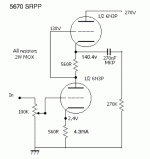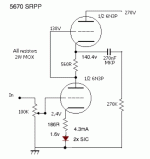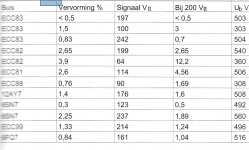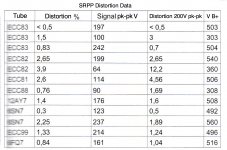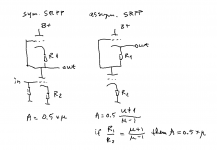Yes, but that introduces a nonlinear element into the local nfb loop,
which will likely increase the distortion. This also goes part way toward fixed bias,
which will cause more variation of performance and the DC operating point.
which will likely increase the distortion. This also goes part way toward fixed bias,
which will cause more variation of performance and the DC operating point.
Last edited:
Making the two cathode impedances different destroys the nice balanced operation of the SRPP, which is about the only thing it had going for it..
Jan
Jan
Looks like you're not a fan. I noticed SY suggested a red LED for the lower cathode in another thread.Making the two cathode impedances different destroys the nice balanced operation of the SRPP, which is about the only thing it had going for it..
Jan
Would the "nice balanced operation" be much affected if a different tube were used in the top position, but a tube with very similar operating conditions?
Depends on what you want. In an SRPP with equal Rk and equal mu (say a double-triode), the voltage gain A computes to 0.5*mu.
So taking different triodes and different Rk (like one decoupled, the other not) destroys that nice relation ship and increases distortion.
BTW, this is the same reason why you should use an ECC83 but not an ECC82; the latter havs much varying mu and thus much higher distortion.
Interestingly, if you make it an asymmetrical SRPP, you find that Rk1/Rk2 should be (mu+1)/(mu-1) so in this case, the two Rk's need to be different for max performance.
Jan
So taking different triodes and different Rk (like one decoupled, the other not) destroys that nice relation ship and increases distortion.
BTW, this is the same reason why you should use an ECC83 but not an ECC82; the latter havs much varying mu and thus much higher distortion.
Interestingly, if you make it an asymmetrical SRPP, you find that Rk1/Rk2 should be (mu+1)/(mu-1) so in this case, the two Rk's need to be different for max performance.
Jan
What do you think of the ECC88 as an SRPP choice?Depends on what you want. In an SRPP with equal Rk and equal mu (say a double-triode), the voltage gain A computes to 0.5*mu.
So taking different triodes and different Rk (like one decoupled, the other not) destroys that nice relation ship and increases distortion.
BTW, this is the same reason why you should use an ECC83 but not an ECC82; the latter havs much varying mu and thus much higher distortion.
Interestingly, if you make it an asymmetrical SRPP, you find that Rk1/Rk2 should be (mu+1)/(mu-1) so in this case, the two Rk's need to be different for max performance.
Jan
Cheers
IAn
Incidentally, what's the formula for the gain of an SRPP stage, preferably with a worked example?
I believe its less than the mu of the tube but by how much? That could be one of its disadvantages compared to a choke or active load, or even a large resistor?
I believe its less than the mu of the tube but by how much? That could be one of its disadvantages compared to a choke or active load, or even a large resistor?
For a symmetrical one with equal Rk's it is A = 0.5*mu.Incidentally, what's the formula for the gain of an SRPP stage, preferably with a worked example?
I believe its less than the mu of the tube but by how much? That could be one of its disadvantages compared to a choke or active load, or even a large resistor?
I have the derivation here but not sure I want to copy it ...
Jan
Ian, these are the results from Dieleman. As an overall finding he says that most often bad results come from using too low B+. See for instance difference between line 1 and line 2.What do you think of the ECC88 as an SRPP choice?
Cheers
Ian
The table headings: Vervorming = distortion, Signaal Vtt is the peak-to-peak signal level for this distortion, Bij 200 Vtt is the distortion with 200V peak-peak signal, Ub V = B+.
Jan
Attachments
Thanks for the info and the translation. It seems to me that at an B+ of around 300V, the ECC88 has about half the distortion of the ECC83 which I find very encouraging as I use them all the time under very similar conditions. However, there seems to be no mention of either the quiescent current of the load under which the measurements were made. For example, an ECC88 SRPP will easily drive 150Vpp into a 2400 ohm load with a 300V supply but an ECC83 will not.
Cheers
Ian
Cheers
Ian
I would have to go through the whole article, but it looks like 2-5mA and a load that keeps it in class A.
Jan
Jan
Thanks Jan, 2mA is about to of the range for an ECC83 and 5mA is very close to where I run my ECC88s so that fits quite nicely. I don't suppose he gives schematics of the circuits tested?I would have to go through the whole article, but it looks like 2-5mA and a load that keeps it in class A.
Jan
Cheers
Ian
It's a very simple circuit, to basics, see attached.
He calculates distortion by driving with a small signal, a few Vac, then measuring the pos and neg peak output voltages V1 and V2 with respect to the quiescent Vo. Then the 2nd harmonic D2 = 0.5 * (v1-v2)/(v1+v2).
Example: ECC81, B+ =506V, Ia = 5.3mA, Vgk = -3V gain = 28x
Driving with 2V, V1 = 60.3V, V2 = 54.4V. D2 = 0.5* (60.3-54.4)/(60.3 + 54.4) = ~2.6%
His conclusion: ECC81 totally unfit for SRPP duty.
A similar example with ECC88 gives D2 = ~0.76%
I think these numbers are also in the table I posted earlier.
He calculates distortion by driving with a small signal, a few Vac, then measuring the pos and neg peak output voltages V1 and V2 with respect to the quiescent Vo. Then the 2nd harmonic D2 = 0.5 * (v1-v2)/(v1+v2).
Example: ECC81, B+ =506V, Ia = 5.3mA, Vgk = -3V gain = 28x
Driving with 2V, V1 = 60.3V, V2 = 54.4V. D2 = 0.5* (60.3-54.4)/(60.3 + 54.4) = ~2.6%
His conclusion: ECC81 totally unfit for SRPP duty.
A similar example with ECC88 gives D2 = ~0.76%
I think these numbers are also in the table I posted earlier.
Attachments
Thanks once again Jan. So the bottom Rk is not bypassed and there is no load. I really need to learn Dutch and read this book. I am 71 years old - I wonder if I have the time?
Cheers
Ian
Cheers
Ian
I did not know that. Can you give an example?SRPP used to be used in old valve TV's for driving a speaker.
Cheers
Ian
It has a lowish output impedance out hence use for driving TV speaker.
It was just the circuit shown in this thread.
It was just the circuit shown in this thread.
- Home
- Amplifiers
- Tubes / Valves
- SRPP with SIC diode bias
